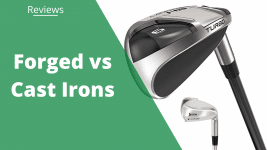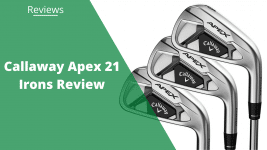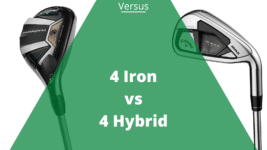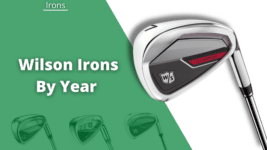6 irons are often considered to be a hard iron to hit. But hitting it, and the other mid-irons, well, can be the difference between getting low scores or finishing over par, so you should master how to use one in either case.
Whether it be its ability to assist with getting out of tough lies or its ability to execute a diverse range of shots with elevated accuracy, having one in your bag is often a plus if you know how to properly strike with it.
But what’s the best way to learn how to hit a 6 iron? And what are the best 6 irons on the market?
Read on to learn the pros, cons, and prices of the best 6 irons – including distance and swing speed charts.
What is a 6 Iron & When Should You Use It?
Generally, irons are classified according to their lofts, lengths, and occasionally what they are mostly used for when on the course.
Depending on their lengths and lofts, you can classify irons as short, mid, or long.
The pitching wedge, 8 iron, and 9 iron are classified as short irons. The 5 iron, 6 iron, and 7 iron are categorized in the mid-iron range. Finally, the 2 iron, 3 iron and 4 iron are classified as long irons.
Also, irons can be classified according to their head construction, commonly as being a blade-style iron or cavity back. Each type is designed to suit varying degrees of skill, and both types can come as 6 irons.
Therefore, a 6 iron can be classified in a simple manner as a mid iron with an average loft of between 24°-31°. It usually has an average length of between 37.5 inches for men and 36.5 inches for women.
Read Next: The Best Golf Irons
Benefits of Using a 6 Iron
While the 6 Iron is known to be a hard club to hit, it can come in handy in some situations when playing on the course. Here are a few benefits of having the 6 iron in your bag:
- Accuracy: The 6 iron will be more accurate than other options, such as a hybrid, especially with shots into the pin.
- Reduce wind drag: Because their lofts cut through the wind, they can often be the perfect club to play with in harsh conditions.
- Play out of the rough: Its loft configuration is ideal for hitting balls out of tough lies.
- High launch: Its loft makes it easier to shape high-launch shots.
How To Hit a 6 Iron
As stated earlier, knowing how to hit with a 6 iron can significantly lower one’s score. While you will often hear players complain about how hard it is to hit a 6-iron, it is no different from any other club. With practice and proper technique training, you can hit it easily in no time.
The best way is to find a professional trainer who will guide you on properly hitting. Learning with a pro is always the best way, as they will often give on spot guidance on proper technique and help with correction of any mistakes that may affect your playing in the long run.
Here’s how to hit a 6 iron, according to Matt Meyer from Thousand Hills Golf Resort.
Follow these quick steps to hit a 6 iron:
- As you probably know, an important aspect of any shot is your address/ball position. Ideally, the ball should be in the middle of your stance, your sternum should be aligned with the ball, and you want to keep your feet apart by a distance similar to your shoulder width.
- When holding the shaft, have your hands in a relaxed central position with a firm but not too tight grip.
- Have decent power on the swing while on the takeaway. The takeaway is the beginning of your swing. Ideally, you want to start by turning your hips and following through with your shoulder and arms until the club is positioned parallel to where it started.
- Ensure that you are balanced and stable with good weight distribution.
- Complete the backswing by ensuring your hands, hips and shoulders rotate back towards their natural mid position and follow through after you hit the ball.
- An important thing to remember when hitting with a 6-iron is that impact should be on the lower part of the ball.
- Lastly, persistently practice with a six iron until you are comfortable and consistent.
Bonus Tips For Hitting a 6-Iron Further
- Work on your swing speed while maintaining accuracy. If you’re maxed out, you could try switching to a graphite shaft instead.
- Make sure you strike the lower section of the ball for the best movement off the face.
Read More: The Most Forgiving Golf Irons
What Is the Average 6 Iron Loft?
All irons are angled to a certain degree relative to the straight line created by the shaft and leave a certain space from the ground. This degree angle is referred to as the loft, one of the parameters used to classify irons as either mid, long, or short.
The greater the loft, the higher the launch trajectory, the reverse is also true.
Each type of iron is designed to have a certain range of launch trajectories they can easily achieve. Other factors, such as the direction and spin of the ball, can also be controlled by the loft.
Typically, the lofts of 6 irons range from 24°-31°. This type of loft makes them usable in approach shots and very useful in getting out of tough lies.
What Is the Average 6 Iron Length?
The average length of a 6-iron will vary depending on whether it is a women’s club or a men’s club. Commonly, women’s shafts tend to be shorter than those of men. This is usually in line with the average heights of men being more than women’s.
Also, the lengths usually vary depending on whether the shaft is made of steel or graphite, with graphite shafts being longer.
The standard 6-iron length for a steel shaft is 36.5 inches for women and 37.5 inches for men.
On the other hand, the standard length of a 6-iron graphite shaft is 37 inches in women and 38 inches in men.
It is important to note that these are just the standard lengths and can be adjusted according to different players’ heights.
While the standard lengths will work with most players, getting fitted with a professional is important to find what works best for you. This is because the length of your 6 iron will affect your overall distance and impact your launch trajectories when playing. Generally, the taller you are above average height, the longer your 6 iron may need to be, and vice versa.
6 Iron Swing Speed
One of the most important determiners of the average 6 iron distance you will be able to achieve hitting with a 6 iron is your swing speed. Swing speed varies with different ages and skill levels. There is usually a decline in swing speed with an increase in age; generally, higher-skilled players tend to have faster swing speeds.
Here is an average swing speed chart for players of different skill-level.
| Player Lever | Swing Speed For Men | Swing Speed For Women |
| PGA Pro | 92 mph and above | 78 mph and above |
| Low Handicappers | 85 mph and above | 70-80 mph |
| Mid Handicappers | 70mph and above | 60 mph and above |
| High Handicappers | 60-70mph | 60mph and below |
How Far Does a 6 Iron Go?
Each type of iron will be designed to achieve a specific distance range. Even then, the ranges will vary depending on many factors. Most commonly, the 6 iron distance will vary according to the players’ ages, swing speed, skill levels of different players and the playing conditions at any given time.
Here is a table representing the average distances by players of different skill levels with a 6 iron.
| Player Skill Level | Distance For Men | Distances for women |
| High Handicappers | 130 Yards | 70 Yards |
| Mid Handicappers | 150 Yards | 100 Yards |
| Low Handicappers | 160 Yards | 130 Yards |
| PGA/LPGA Tour Pros | 180-230 Yards | 150-160 Yards |
The Best Iron Sets with 6 Irons
1) TaylorMade P790 Irons
6 Iron Specifications
- Loft – 30.5°
- Lie – 62.5°
- Offset – 2.7 mm
- Length – 37.00″
Pros
- Tungsten weight optimizes CG to make the club more stable and precise.
- SpeedFoam insert results in a soft feel and satisfying sound.
Cons
- Not the most forgiving irons.
- Not workable compared to other similar irons.
The TaylorMade P790 Iron is made with a new type of 8620 carbon steel that TaylorMade claims is thinner in select areas than the club’s predecessors. This material combines with the special 4140 steel face to optimize the club’s overall center of gravity properties and as a result, make it more forgiving with heightened distance and increased ball speeds.
The P790 also features a new Taylormade-formulated SpeedFoam Air insert which is significantly lighter than previous inserts (up to 69% lighter). This is in a bid to give players a soft feel when using the club and to absorb vibrations from impact resulting in a good sound. That makes these some of the best irons for those that want a smooth strike.
A lower-placed thirty-one gram Tungsten insert makes the TaylorMade P790 easier to hit when it comes to high launch shots. The Tungsten weight also balances out the club’s redistributed weights for an optimal overall CG making it more stable and forgiving to players. This is perfect for making a more forgiving 6 iron than much of the competition.
2) Mizuno Pro 221 Irons
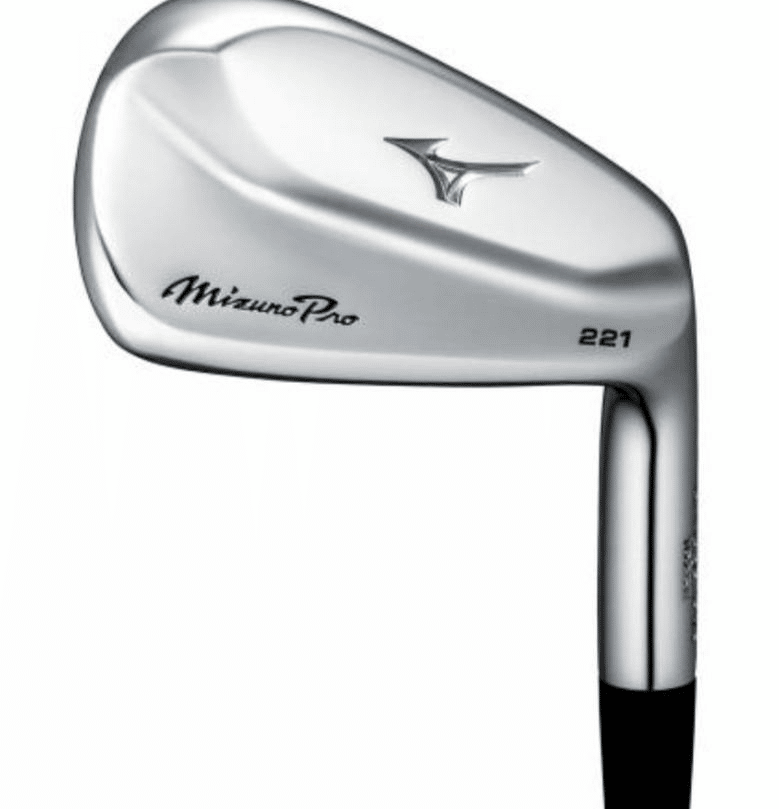
6 Iron Specifications
- Loft – 34°
- Lie – 61.5°
- Offset – 0.087″
- Length – 37″
Pros
- Stylish Compact Muscleback blade design.
- Workable.
- Designed for fast ball speeds and give players maximum shot control
Cons
- No left-handed options.
- There are better options if you are going for distance.
For players looking for a Muscleback-style iron, the Mizuno Pro 221 iron is undoubtedly one of the best options in the industry.
Designed in Japan, the Mizuno Pro 221 irons are made with the highest quality 1025E carbon steel to give them a compact, strong and durable design. At address, they sport a smaller design with a shorter blade, and thin topline and are topped off with a chrome Nickel finish.
The Mizuno Pro 221 are fitted with a unique copper underlay that is put just under the Nickel Chrome body to give them the softest feel and to enhance sound quality upon impact.
While the Mizuno Pro 221 is designed to suit a diverse range of players, this is going to be ideal for players with fast swings. In other words, you’ll need a fast swing speed to hit the 6 iron golf club from this set accurately, so keep this in mind.
3) Callaway Apex DCB 21 Iron
6 Iron Specifications
- Loft – 30°
- Lie – 62.5°
- Offset – 3.56 mm
- Length – 37″
Pros
- High ball speeds.
- Ample forgiveness levels.
- Soft feel and good sound as a result of Urethane Microspheres.
Cons
- Aesthetic design is not every player’s cup of tea
- Expensive.
The Callaway Apex DCB 21 Iron comes fitted with a premium A.I designed Flash Face Cup, engineered to give players the highest control levels and enable them to enhance their distances. The body has premium Carbon Steel that combines with special Urethane Microspheres for enhanced sound and feel when using the club.
Players get increased forgiveness levels and easier, more consistent launches by incorporating a 50-gram Tungsten weight that optimizes the club’s Centre of gravity.
Ideally, the Callaway Apex DCB 21 irons are targeted players that are in search of an iron that offers the fastest ball speeds and high forgiveness levels. This set is perfect for mid to low-handicappers trying to master a six-iron golf club.
Frequently Asked Questions
What Is a 6 Iron Used For?
Notably, the 6 iron is often suited for getting you out of tough lies. Most of them have a 28° loft, ideal for taking balls out in such situations. You can also use them for approach shots. This generally ranges anywhere from 150-180 yards.
Why Is It So Hard To Hit a 6 Iron?
Generally, the hardest clubs to hit are usually the longest. For this reason, the 6 iron is often not the easiest club to hit, the fact that it is usually the first long(er) iron most players encounter transitioning from short and mid-length irons.
Should I Carry a 6 Iron?
Apart from the fact that a 6 iron can come in handy in tough lie scenarios, there are tons of other situations where a 6 iron can come in handy. For instance, they are often better in windy conditions because of their loft. Also, as controlling them is easy, you may find them useful in approach shots.
Can You Chip With a 6 Iron?
Yes, you can. A 6-iron chip can be pretty useful in getting out of a tough lie or when you need to make a long chip. You’ll have to adjust how you strike the ball significantly, though.
What Club Can Replace a 6 Iron?
Because of the extra versatility options that come with it, most golfers will find that the best replacement for a 6 iron is often a 6 hybrid. Some would argue a 5 wood is close enough too.
Wrapping Up
After reading this guide, you should now understand better when to use a 6 iron, how to hit one, and which one to buy to suit your needs. Just remember, the key is that when you strike the ball it should be on the lower part of the ball.
Also, if you’re looking to add a new 6-iron to your set, the Taylormade P790 irons are a great addition with high launch.
Chris's love for golf is only rivaled by his wanderlust. A globetrotter at heart, He’s played courses throughout Europe and Asia and at home in NSW, Australia. With a writing style as smooth as his golf swing, he’ll help you find the right gear to match your skill level and style. You can connect with Chris on LinkedIn.

